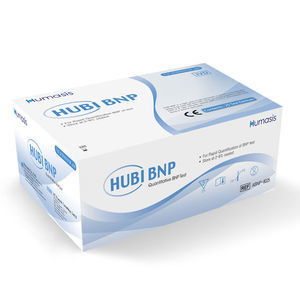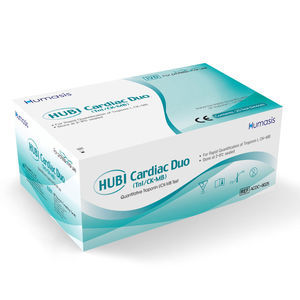

- Products
- Catalogs
- News & Trends
- Exhibitions
Rapid myocardial infarction test AFACT-8025cardiac troponin Ih-FABPplasma
Add to favorites
Compare this product
fo_shop_gate_exact_title
Characteristics
- Applications
- for myocardial infarction
- Tested parameter
- cardiac troponin I, h-FABP
- Sample type
- plasma, whole blood
- Analysis mode
- molecular
- Format
- cassette
Description
The HUBI FABP-Troponin I is a rapid, point of care test based on immunochromatography assay to be used with the HUBI-QUAN pro for the quantitative measurement of Heart type Fatty-acid Binding Protein (H-FABP) and cardiac Troponin l(cTnl) in EDTA anticoagulated whole blood or plasma specimens.
Early diagnosis is important in acute myocardial infarction (AMI), Therefore, the diagnostic method with better accuracy and rapidity is crucial to improve management of patients with suspected AMI. The Fatty-acid Binding Proteins (FABPs) are relatively small cytoplasmic proteins (15 kDa) and rapidly released from the cells into the circulation shortly after the onset of the cell damage. There are several kinds of FABPs which are tissue-specific. H-FABP is reported to be one of the earliest marker for injured myocardium and the concentration of H-FABP in blood will increase reliably within 6 hours after onset of myocardium injury. The H-FABP has high cardiac specificity because the H-FABP content in cardiac is approximately ten times higher than skeletal muscle.
Cardiac troponin I (cTnl) is a cardiac muscle protein with a molecular weight of 22.5 kilo Daltons. Together with cardiac troponin T (cTnT) and cardiac troponin C (cTnC), cTnl forms a troponin complex in heart which plays a pivotai rôle in the transmission of intracellular calcium signal and régulation of actin-myosin interaction. cTnl is more specific and sensitive than cTnT in diagnosis of AMI condition.
Related Searches
- Assay kit
- Blood assay kit
- Serum assay kit
- Immunoassay assay kit
- Plasma assay kit
- Infectious disease detection kit
- Blood rapid diagnostic test
- Rapid lateral flow test
- Immunoassay rapid diagnostic test
- Cassette rapid diagnostic test
- Molecular test kit
- Serum rapid diagnostic test
- Whole blood detection kit
- Plasma rapid diagnostic test
- Infectious disease rapid diagnostic test
- Whole blood rapid diagnostic test
- Cassette assay kit
- Lateral flow test kit
- Urine rapid screening test
- Oncology test kit
*Prices are pre-tax. They exclude delivery charges and customs duties and do not include additional charges for installation or activation options. Prices are indicative only and may vary by country, with changes to the cost of raw materials and exchange rates.






